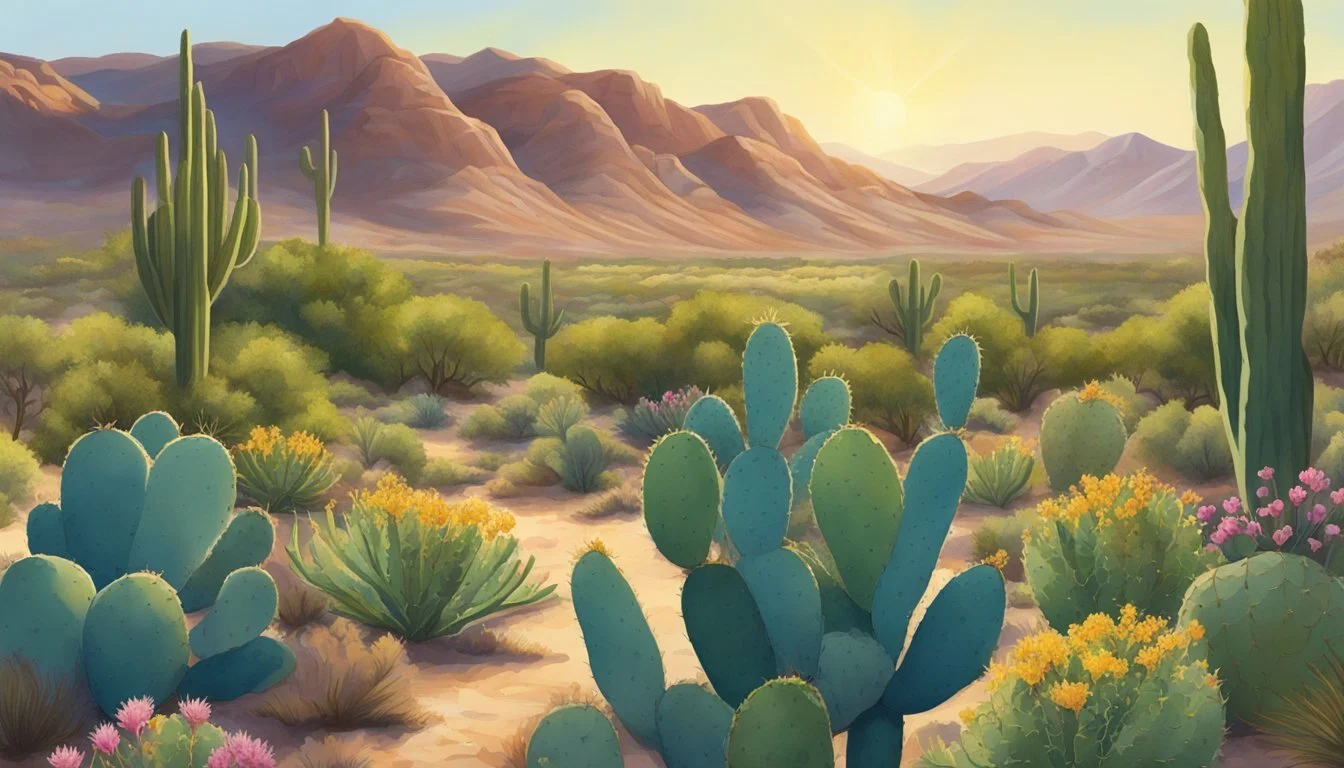Four Corners Native Edible Plants
Discovering Local Culinary Treasures
The Four Corners region, encompassing areas of New Mexico, Arizona, Colorado, and Utah, boasts a rich variety of native edible plants that have been integral to the traditional diets and cultures of Native Peoples for centuries. This fascinating botany not only reveals the scientific diversity of the region but also the deep historical and cultural connections maintained by indigenous communities. Among these edible plants are berries like raspberries, thimbleberries, chokecherries, and elderberries, which have traditionally been used to make pemmican and preserves.
Exploring the traditional uses of these plants offers a window into the daily lives and practices of Native Peoples. Plants like greasewood, which are vital for both their nutritional value and their uses in crafting tools and ceremonial items, highlight the multidimensional relationships between humans and nature in the Four Corners area. Understanding these plants’ roles in historical and contemporary contexts enriches our appreciation for their resilience and utility.
From grinding various seeds into flour for baking to utilizing the versatile greasewood for tools and dyes, the native flora of this region underscores a legacy of ingenuity and sustainability. Learning about these plants deepens our appreciation for the science and traditional knowledge that has been passed down through generations, prompting us to consider how modern practices can draw lessons from ancient wisdom.
Historical Context
The indigenous inhabitants of the Four Corners region have a rich and intricate history intertwined with the cultivation and use of local edible plants. This history is evident through early agriculture, traditional diets, and findings from archaeological sites.
Early Inhabitants and Agriculture
The Four Corners region, encompassing parts of Arizona, Utah, Colorado, and New Mexico, has been home to various Native American tribes such as the Pueblo, Navajo, Ute, Apache, and Hopi. These early inhabitants practiced diverse agricultural techniques that were finely tuned to the arid environment.
They cultivated staple crops like corn, beans, and squash, known collectively as the "Three Sisters." These crops were integral to their diet and were often grown together for their symbiotic benefits — corn providing support for beans, beans adding nitrogen to the soil, and squash offering ground cover to reduce weeds.
Traditional Foods of the Four Corners Nations
The traditional diets of the Four Corners nations included a variety of native plants and foods. The Pueblo people, for example, relied heavily on cultivated crops and wild plants. The Navajo incorporated wild berries and piñon nuts, while the Apache used an array of tubers and seeds.
The Four Corners potato (Solanum jamesii) is one of the region's unique edible plants. This wild potato was used by several tribes due to its nutritional benefits and ability to thrive in local soils. Wild berries, seeds, and various greens also played crucial roles in the diets of these communities.
Archaeological Sites and Plant Remains
Significant archaeological sites such as Mesa Verde National Park, Chaco Canyon, Canyon de Chelly, Aztec Ruins, and Hovenweep provide a glimpse into the prehistoric uses of plants in the Four Corners region. Excavations at these sites have uncovered evidence of ancient agricultural practices and plant domestication.
For instance, at Mesa Verde, charred corn cobs, squash seeds, and bean remains indicate extensive farming activities. At Chaco Canyon, storage pits suggest long-term food preservation. These findings illustrate the complex relationship between the inhabitants and their environment, highlighting their adaptability and innovation in agriculture.
Native Flora of the Four Corners
The Four Corners region hosts a rich variety of native plants crucial for both ecological balance and cultural significance. This diversity spans trees, shrubs, herbaceous perennials, and grasses, each uniquely adapted to local habitats.
Diversity of Species
The Four Corners region boasts over 200 documented plant species. These include trees, shrubs, herbaceous perennials, and grasses. Chokecherry (Prunus virginiana) and other members of the Rosaceae family are common.
Other notable plants include species from the Asteraceae and Fabaceae families. Indigenous peoples have historically relied on many of these plants for food, medicine, and other uses.
Plant Classifications
Plants in this area can be classified into families such as Asteraceae (sunflower family), Fabaceae (legume family), Polygonaceae (knotweed family), and Rosaceae (rose family). For instance, members of the Asteraceae family include sagebrush and sunflowers.
For edible uses, chokecherry (Rosaceae), wild onion (Allium spp.), and amaranth (Amaranthus spp.) are noteworthy. These classifications help in understanding plant relationships and their ecological roles.
Habitats and Growing Conditions
Native plants of the Four Corners thrive in various habitats from arid deserts to grassy meadows and riverbanks. Common habitats include sagebrush flats, pinyon-juniper woodlands, and riparian zones.
These plants are incredibly resilient, often thriving in poor soils and requiring minimal water. They have adapted to harsh conditions, making them crucial for stabilizing soil and supporting wildlife.
Ethnobotanical Knowledge
Ethnobotanical knowledge encompasses how Native and Indigenous Peoples have traditionally used local plants for food, medicine, and other purposes. This section explores the traditional and contemporary uses of native edible plants in the Four Corners region.
Traditional Uses of Plants
Native and Indigenous Peoples have a deep understanding of local flora, using it for everyday needs and rituals. Many plants serve multiple purposes, from food to medicine and crafting materials.
For example, the Navajo and Hopi peoples utilize the Amaranthus species as both a grain and a leafy vegetable. The Yucca plant provides soap from its roots and strong fibers for weaving baskets and constructing shelters.
Additionally, the Prickly Pear Cactus (Opuntia) is crucial. Its pads are edible when cooked, and it also yields medicinal properties to treat wounds and digestive issues.
Contemporary Uses and Practices
Modern practices have evolved but continue to reflect traditional knowledge. Today, these plants are integrated into sustainable food practices and alternative medicine.
The resurgence in using native plants for food—like the Three Sisters (corn, beans, squash)—helps maintain biodiversity and cultural heritage.
In urban settings, community gardens grow these plants to educate about sustainable living. Dye plants, like wild sumac, remain relevant for creating natural colors used in fabrics and crafts.
Medicinal uses persist, too. Echinecea is still popular for its immune-boosting properties, available in many health stores. The traditional knowledge continues to be a source of resilience and innovation respecting the land and its resources.
Cultural Significance
The cultural significance of native edible plants in the Four Corners region is deeply rooted in the history and practices of Native American communities, encompassing traditional agricultural techniques and the ongoing relevance of these plants.
Traditional Native American Agricultural Practices
Native peoples of the Four Corners area employed sophisticated agricultural techniques to cultivate native plants. These practices included irrigation systems, crop rotation, and companion planting. Farmers utilized terrace farming to effectively manage water resources in arid conditions.
They also relied on deep knowledge of local flora to select plants that thrived together. Corn, beans, and squash, known as the "Three Sisters," were often grown together. This trio supported each other in growth and contributed to nutritional needs, as corn provided a structure for beans to climb, beans enriched the soil with nitrogen, and squash spread across the ground, blocking weeds.
These techniques ensured sustainable food sources and preserved soil fertility, contributing to the cultural heritage and survival of Native communities.
Modern Day Relevance
Today, native edible plants continue to hold importance for both cultural and practical reasons. Modern initiatives strive to revive traditional practices, promoting these plants for their nutritional benefits and sustainability. They also maintain a connection to ancestral knowledge and cultural heritage.
Programs like community gardens and educational projects teach younger generations about traditional uses and the significance of these plants. Additionally, the rediscovery of these plants has led to their inclusion in contemporary cuisine, highlighting their versatility and health benefits.
By integrating these plants into modern diets and promoting sustainable farming practices, there is a growing movement to preserve the cultural heritage and ecological wisdom embedded in these ancient agricultural traditions.
Conservation and Ecology
Conservation of native edible plants in the Four Corners region involves addressing environmental changes and ongoing preservation efforts.
Impact of Environmental Changes
Environmental shifts in the Four Corners region are significantly affecting the local flora. Climate change is altering precipitation patterns, which directly impacts the growth cycles and health of native plants.
In Mesa Verde National Park, rising temperatures and prolonged droughts are stressing ecosystems. This affects not just the plants but also the wildlife that relies on these species for food and habitat.
Invasive species further complicate the picture, outcompeting native plants for resources. Farmington has reported instances where invasive plants have crowded out native edible varieties, leading to a decline in biodiversity. This competition disrupts the delicate balance within these habitats.
Native Plant Preservation Efforts
Efforts to preserve native plants in the Four Corners region are multifaceted. The University of Utah has initiatives aimed at seed banking and cultivating native species in controlled environments.
Local communities are also involved. Programs in Farmington focus on educating residents about the importance of native plants and provide resources for home cultivation.
Mesa Verde National Park is actively engaged in conservation projects that monitor and protect native plant populations. These efforts include controlled burns and replanting strategies to restore and maintain the health of indigenous species.
Collaborations with organizations like the Food and Agriculture Organization of the United Nations help support these local initiatives by providing guidelines and resources for sustainable conservation practices.
Culinary Applications
Native plants from the Four Corners region offer diverse culinary experiences. These plants are not only packed with nutritional benefits but also allow for creative foraging and cooking methods.
Foraging for Wild Food
Foraging in the Four Corners region can yield a variety of edible plants, ranging from starchy tubers to wild herbs. Native species like the Four Corners potato, which has a rich history of usage by indigenous peoples, are known for their resilience and nutritional value.
Edible seeds, leaves, and roots can be collected with careful identification. Tools like a sharp knife and a good field guide are essential. Some plants can even be ground into flour using a coffee grinder or blender and incorporated into recipes, such as mini-muffins or traditional bread.
Nutritional Value of Native Plants
Many native plants from the Four Corners are rich in nutrients, providing essential proteins, vitamins, and minerals. For example, the ancient Four Corners potato is a small tuber packed with proteins and vitamins, making it a powerful source of nourishment.
In addition to proteins, plants such as these often contain minerals like manganese and calcium, crucial for bone health and metabolic functions. These nutrients make them excellent components of a balanced diet.
Wild food gathered from this region contributes not just to the nutritional table but also introduces unique flavors to contemporary cooking.
Scientific Research
Scientific research into native edible plants in the Four Corners region explores the botany, natural history, and conservation efforts related to these species. This section delves into recent botanical studies and the unique genetic traits of certain plants.
Recent Botanical Studies
Recent investigations have focused on understanding the nutritional profiles and ethnobotanical importance of wild edible plants (WEPs) such as the Four Corners Potato (Solanum jamesii).
Bruce Pavlik's studies highlight its high iron content and potential to combat diseases related to iron deficiency.
Research led by Lisbeth Louderback emphasizes the historical significance of these plants to indigenous diets.
Conservation efforts have increased due to findings supporting the plants' resilience and nutritional benefits. Studies often include collaborations with local communities to document traditional knowledge and promote sustainable harvesting practices, ensuring these plants' availability for future generations.
Unique Edibles and Genetics
Wild edible plants in the Four Corners exhibit unique genetic adaptations.
Solanum jamesii, a wild potato variety, possesses genetic traits for drought resistance, crucial for survival in arid conditions.
Genetic studies reveal that the plants' ability to produce tubers from seeds enhances their evolutionary advantage. This attribute is significant for conservation strategies.
Other edibles, like certain endemic species of fruits and seeds, have been examined for their unique chemical compositions and nutritional properties. Understanding these genetic factors aids in conservation and potential agricultural applications, offering insights into cultivating resilient food sources amid changing climatic conditions.
Educational Resources and Community
In the Four Corners region, various educational resources are available to learn about native edible plants. These resources include both local programs and online platforms, each contributing to the understanding and appreciation of indigenous flora.
Local Educational Programs
Different institutions and organizations offer courses and workshops dedicated to native plants. Navajo Technical University hosts programs that highlight traditional plant uses, merging scientific knowledge with indigenous wisdom. The Cortez Cultural Center provides hands-on learning experiences in Hawkings Preserve, focusing on over 200 documented plant species.
Farmington and Escalante, Utah also support local workshops. Participants learn plant identification, cultivation methods, and sustainable harvesting practices. Collaborative efforts in these communities help preserve indigenous knowledge and promote ecological stewardship.
Online Learning Platforms
Several online platforms provide accessible educational resources on native edible plants. The "Native Plants and Foods Curriculum Portal" features toolkits to explore native plants of the Pacific Northwest, emphasizing indigenous traditions. This resource is particularly valuable for remote learners.
Websites like Swcoloradowildflowers.com offer detailed information, including plant identification guides, habitat details, and usage notes. Virtual libraries and digital archives from botanical gardens, such as the Missouri Botanical Garden Press, provide extensive literature on the subject. These platforms support continuous learning and community engagement, making knowledge accessible to a broader audience.







